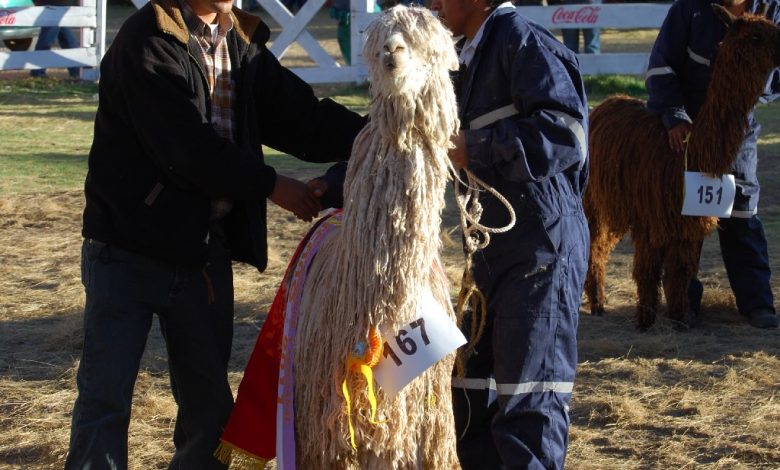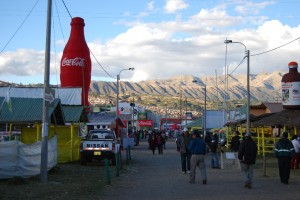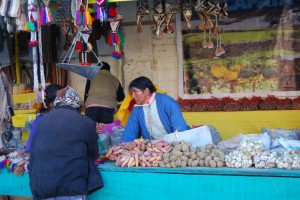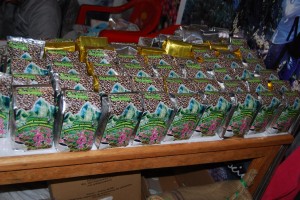A Pageant, a Fair, and Food

The sun bathes Cuzco in its light these days. It moves through the city like a guardian, illuminating first this detail and then another. It makes the city’s stones come alive. They seem to move and change as the sun washes across them. The clouds that weakened its enlivening gaze are mostly gone. Some days they do boil up from the jungle, but mostly the sun, though weak, rules the sky and the city’s streets.
Today is Inti Raymi and Cuzqueñans dressed in brightly colored, romantic versions of what people imagine Imperial dress might have been like wait to catch its rays to receive the gift it brings. Cuzco’s downtown — from what remains of the ancient temple of the sun, the Qori Cancha (a rounded black stone wall on a bluff overlooking a plain, a pampa, where a river used to flow, before it was forced under the street) to the main square, and up the hill to the temple complex above known as Sacsayhuaman — has become a stage for a pageant.
It is a massive project, like something imagined by a Cecile B Demille, replete with lots of melodramatic, hollywood-esque music and dance. Though removed from traditional, indigenous aesthetics and styles, nonetheless it hopes to re-create at least something of the high imperial ritual of the sun and its movement on this, the so-called coldest day of the year.
Cuzco’s elites, enthralled with hopes of an Incan revival as something that could give them power in local and national negotiations created the Inti Raymi pageant. It was built in engagement with the chronicle left by the Inca Garcilaso de la Vega in the sixteenth century. He was the son of a royal woman and a Spaniard, a mestizo like many who were to become Cuzco’s elite.
Instead of the ordinary language and style of the people of Cuzco who keep much of Inca life alive with little fanfare, the pageant needed ringing trumpets and so a style was chosen appropriate to the time of the great filmmakers like DeMille. This required the use of Capac Simi, or High Quechua which Cuzco’s elites argued about and maintained.


It was hoped this would become a great, world festival defined by the crowds of tourists it draws and its ways of reorganizing local life under elite direction. To this end Inti Raymi is marketed heavily to tourists and Cuzco’s elites, along with national and international promoters of tourism, as the hallmark of the city’s claim to its Inka past.
But, to asses significance one can do far worse than following the food. A dish, chiriuchu, is associated strongly with Corpus Christi which in its own way claimed the ancient Inti Raymi at the same time it sought to arrest it. Though vendors climb to Sacsayhuaman to sell a range of regional dishes to people who congregate there for the pageant, no food is really connected with the pageant.

Instead, the food is in suburban Huancaro today, and so are Cuzco’s people. And it is not only food, but games, electronic huayno music — along with cumbia and salsa — as well as dance. Displays also emphasize the stuff of the modern marketplace. People can eat, dance, compete, see agricultural products, and displays of mattresses and household electronics.
There is a secret in Cuzco, a sacrilegious secret. People will speak the official praise of Inti Raymi but if one keeps talking, with a shy somewhat embarrassed giggle they will admit to heterodoxy, boredom. Unless they are performing, they are likely to be at Huancaro’s fair.
It is a state fair. People come from all over the department of Cuzco bringing their alpacas, sheep, and cattle to be judged; they also bring their potatoes, ocas, bananas, beans, avocados, and other produce.

The suburb of Huancaro sits on an edge of the valley of Cuzco in a bowl, a short taxi ride from the city’s center. Located on the valley floor, where the land is flat, Huancaro has hills rise close above it, with homes perched on much of the steep slope. But when music events happen, like today, people fill not only the fair grounds to listen and dance, they also cling to the slope to hear the music as it rises into the air.
At the fair, people can try new products made from potatoes, such as soft drinks, as well as chips with a whole bunch of un-doctored colors and flavors. The hundreds of different kinds of tubers are on display from elongated yellow ones to bumpy black ones, with one called in Quechua the heart that bleeds because inside it is dark red.
Besides all the produce and the animals, where urbanites can remember their rural roots and ooh and ahh over the various animals and fruits, there is a small ferris wheel and other carnival games.

The food court is large and serves not only specialties from all over Cuzco, such as juane from the jungle, or kankacho which spread over from Puno, but also gyros.
And then, there is the large, covered display area sponsored by the Coffee and Chocolate cooperative COCLA. Inside you can buy earrings, taste and buy sausage, cheese, and even snow cones.
The coffee that recently won a denomination of origin, Huadquiña Machu Picchu, which is hard to find in the city of Cuzco, is also available. Yo can buy it either roasted and ground, as roasted fragrant beans, or as green raw coffee beans to roast yourself.

While tourists enjoy the pageant of Inti Raymi with its seriousness, color, and Velveeta, most people of Cuzco will either be making huatia –potatoes and other food baked in an earth oven, or will be bouncing at the fair of Huancaro. Instead of pageantry and romantic memory, they will be living their customs and their life. While today is the heaviest day at the fair, the fair goes through the 28th of June.





Tremendous writing!